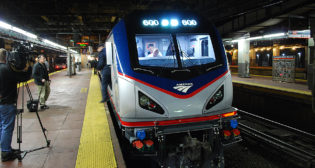
Amtrak touts strong cost-recovery ratio
Written by Douglas John BowenAmtrak President and CEO Joe Boardman, addressing a Congressional committee Tuesday, said Amtrak is leveraging record ridership to reduce dependence on federal operating subsidies.
Boardman, addressing the House Transportation & Infrastructure Committee, said that in fiscal year 2012, ending Sept. 30, 2012, the federal government covered just 12% of Amtrak’s operating costs, while Amtrak generated 88% with ticket sales and other revenue.
The figure compares favorably to Swiss Federal Railways (SBB), often held as a model of railroad efficiency by many rail experts and observers. SBB routinely posts a revenue-to-cost operating ration in the 80-percentile range; for its 2011 fiscal year, SBB, which handles both freight and passenger operations, reported it received 29% of its income from “public-sector payments.” Traffic income, real estate revenue, and other income sources helped SBB reach a revenue-to-cost operating rate of 81%.
SBB’s standard notwithstanding, Congress over the decades has often urged or demanded that Amtrak become “self-supporting” and cover 100% of its operating costs.
Boardman said Amtrak’s success also can be attributed to the federal government’s commitment to invest capital funds for the Amtrak national network . Capital investment helps to reduce operating costs, supports the existing system, funds solutions to reduce future costs, and provides the infrastructure and equipment to sustain ridership and revenue growth, he said.
“Previous federal capital investment levels have sufficed to keep the system going, but they are not going to be adequate in the future,” Boardman stressed. “If we are to realize rail’s potential, we will need much higher levels of federal capital funding.”
Boardman countered recent criticism of Amtrak’s long-distance trains, saying they serve a by connecting rural communities to larger cities and major urban areas. They also serve passengers with disabilities, the elderly and rural populations that are losing scheduled intercity air and bus service.



